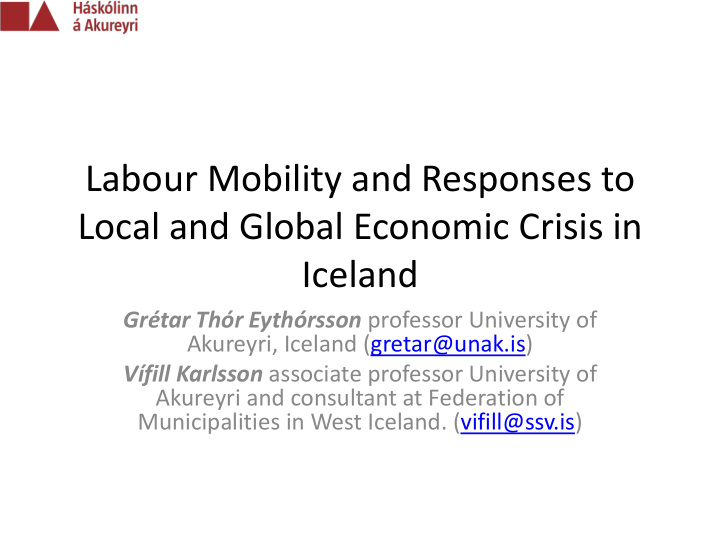



Labour Mobility and Responses to Local and Global Economic Crisis in Iceland Grétar Thór Eythórsson professor University of Akureyri, Iceland (gretar@unak.is) Vífill Karlsson associate professor University of Akureyri and consultant at Federation of Municipalities in West Iceland. (vifill@ssv.is)
Research question • Are there any signs of physical and internal mobility of labour in the rural areas of Iceland after the economic collapse in 2008 and are there any signs of changes of mobility between the years before and after the collapse?
Introduction • Labour mobility a challenge (Storper). • Spatial disparity in regional unemployment (Brunello et al. , 2001) • Income inequalities have fallen on the national level while the income level and unemployment have increased among them on regional level in EU (Pike et al, 2006). • Partly traced back to a lack of labour mobility (Niebuhr, 2003)
Regional unemployment in Iceland in 2005 (0-5.3%) and 2009 (0-12.5%)
Our data • Statistical data – Employed persons by occupational groups (Statistics Iceland) – Employment in Borgarbyggd. Survey made by Regional Development Office of West Iceland – Regional disparity of the impact of the business cycle on local employment level (Karlsson, 2010) • The qualitiative data – From focus group meetings in 2 municipalities
Labour mobility • Physical mobility – Migration : where people try to adapt to new situation on the labour market by moving somewhere else to get a new job. • Internal mobility – Without migration : where people adapt to changes and changed situation by changing job or job sector without moving or by commuting.
Employed persons in the rural area of Iceland before the crisis (2005-2007) and in the crisis (2009-2011)
Employed persons in the capital area of Iceland before and after the crisis
Relative changes between the periods (2005- 2007) and (2009-2011) in employed persons by occupation Occupation Capital area Rural area Legislators and managers 4% 14% Professionals 16% 24% Associate professionals 7% 3% Clerks -30% -41% Service and sales workers -1% 5% Agricultural and fishery workers -18% -5% Craft and related trades workers -11% -2% Plant and machine operators -17% -22% Elementary occupations -26% -30%
The impact of the national business cycle on local employment classified by the weight of selected industries
Data from Borgarbyggð and Fjallabyggð
Borgarbyggð • Amalgamated from 12 municipalities in three steps, between 1994 and 2005. – Covers 5000 km 2 and has 3500 inhabitants. – The service centre is in Borgarnes – 1800 people. • Traditional agriculture – service community • Growth in early 2000´s – Closeness to the capital area • Industries: construction, craft, and food • Educational institutions: two universities and upper secondary school. • Tourism and leisure industry
Borgarbyggð • Collapse in 2008 – Big and important firms went bankrupt • The local bank (saving bank) partly owned by the municipality also went bankrupt. • Large construction firms nearly bankrupt – Some people moved out – Commuting distance from Reykjavík 74 km+ – unemployment became a fact.
Fjallabyggð • Has existed as a municipality since the amalgamation of two fishing towns Siglufjörður(1300 ) and Ólafsfjörður (1100) in 2006. – Opening of a road tunnel made it possible (217 km to 15 km) • Fishing community • Commuting distance from Akureyri (60-75 km) • The crisis not as deep as in Borgarbyggð – New situation more linked to the new tunnel
Adapting to crisis or new situation • Has existed as a municipality since the amalgamation of two fishing towns Siglufjörður(1300 ) and Ólafsfjörður (1100) in 2006. – Opening of a road tunnel made it possible (217 km to 15 km) • Fishing community – Commuting distance from Akureyri (60-75 km) • The crisis not as deep as in Borgarbyggð – New situation more linked to the new tunnel
Employment in Borgarbyggð by industries 2005 and 2010 Other services Health care Education Public administr. Real estate and service Transport Hotels and restaurants Trade Constuction Other industries Fish processing Fishing Agriculture
Adapting to crisis or new situation • This data from Borgarbyggð shows that the workers are flexible and move from low skilled (Plant, machine operators, crafts and related trade workers) to high skilled (professionals, education).
Adaptability in Borgarbyggð • Tradition for dominating Co-operative firm (declining for 20 years, small now) – Therefore limited space for individual initiatives • has put its mark on the attitudes of the older people. – The younger ones are more likely to do something new and put fresh ideas forward. – Greatest initiatives and efforts in establishing new business- ideas have come from adventives. • Historically, Borgarbyggð managed to adapt to structural changes tells us that people should be able to cope with the crisis and adapt • Data shows reduction in commuting between 2005 and 2010 – Fuel prices a big factor here • Labour mobility either physical (migrating out) or internal by changing occupation.
Adaptability in Fjallabyggð • Crisis has led to even more focusing on the fishery sector – Favourable currency rate – Less changes in other sectors (except tourism) • The tunnel has opened for great growth in tourism – New gymnasium school too • Various historical examples of adapting to rationalizations in the fishing sector – Fire truck production – Production and developing of fish processing machines – Aquaculture
Adapting in Fjallabyggð • Lack of commuting data before/after crisis • Changes in commuting (to Akureyri) moderate • Out migration before crisis – no after the crisis • So... – Internal mobility by changing occupation – Perhaps more commuting
Concluding remarks • People of Iceland are responding to the crisis with mobility • Less or similar migration – Moving from rural areas to capital area has slowed down • Less commuting – Higher fuel prices have an impact on commuting • Increased internal mobility by changing job sector • Home sweet home!
Recommend
More recommend